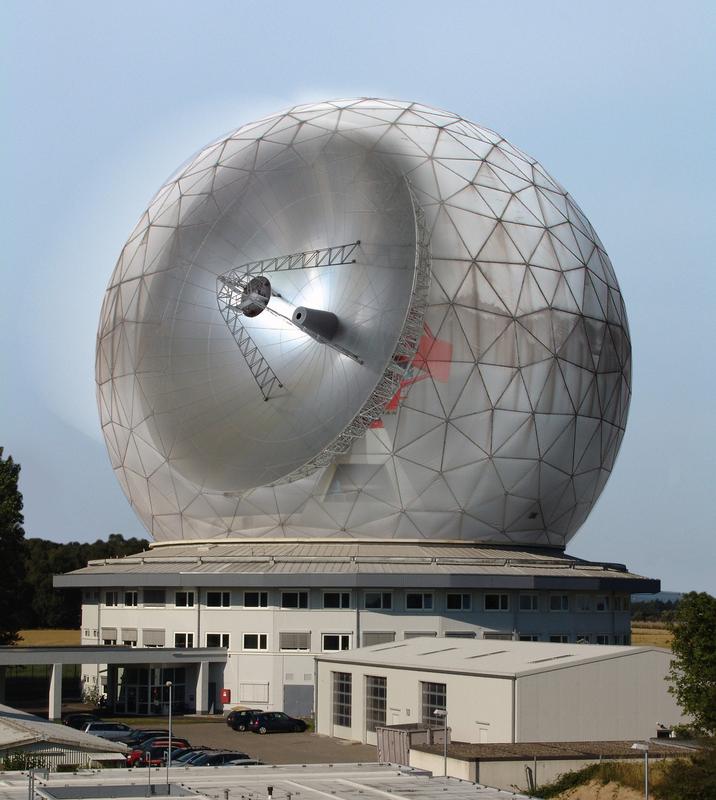Researchers at Fraunhofer monitor re-entry of Chinese space station Tiangong-1

The space observation radar TIRA of Fraunhofer Institute for High Frequency Physics and Radar Techniques FHR in Wachtberg near Bonn in Germany. Fraunhofer FHR
Following the loss of radio contact with Tiangong-1 in 2016 and due to the low orbital height, it is now inevitable that the Chinese space station will re-enter the Earth's atmosphere. With dimensions of approx. 10.4 m x 3.4 m and a weight of 8.5 tons, it can be assumed that at least parts of the space station will reach the Earth's surface.
Only a few sensors worldwide are capable of measuring and imaging space objects such as Tiangong-1 with sufficient precision to acquire high quality data for re-entry forecasts. Here, Fraunhofer Institute for High Frequency Physics and Radar Techniques uses the highly sensitive TIRA system with its 34 m parabolic antenna.
TIRA combines a ku-band imaging radar with an l-band tracking radar. In contrast to optical systems, radar systems such as TIRA offer decisive advantages: complete independence of local weather conditions, full operational capacity during the day or at night as well as a resolution that is independent of the distance of the object. TIRA is capable of imaging space objects with high geometric and radiometric resolution and can also measure their orbital path with the highest precision.
By precisely determining the orbital data of Tiangong-1 until it re-enters at the end of March/beginning of April 2018, FHR offers the German Space Situational Awareness Center valuable support in forecasting the time and place of re-entry. Regular checks are also carried out to establish whether or not Tiangong-1 is still fully intact.
Moreover, the European Space Agency ESA/ESOC in Darmstadt has commissioned Fraunhofer FHR to determine and investigate the natural rotation of Tiangong-1. This rotation greatly influences the flight characteristics of the space station and therefore also influences the time of impact.
Due to the low orbital inclination, Tiangong-1 will re-enter the Earth's atmosphere somewhere between 43°N and 43°S and therefore does not pose a danger for Germany. A more accurate point of impact can only be estimated a few days previous to the actual event as the braking effect of the atmosphere is influenced by a number of factors.
These include the natural rotation speed, the manner in which Tiangong-1 breaks up into several parts, the time of the break-up and the actual weather conditions in space. With TIRA, Fraunhofer FHR supports the Space Situational Awareness Center and the ESA/ESOC with analyses and data and therefore contributes to the improvement of the re-entry forecast.
In its role as one of the leading European institutes, Fraunhofer Institute for High Frequency Physics and Radar Techniques FHR in Wachtberg/Germany conducts extensive research in the area of high frequency and radar techniques. The institute's large-scale space observation radar TIRA possesses capabilities that are unique throughout Europe. The TIRA system primarily serves as a central experimental facility for the development, investigation and demonstration of radar techniques and algorithms for the detection and reconnaissance of Earth-orbiting objects – from active satellites to “space debris”.
Dipl.-Volksw. Jens Fiege
Head of internal and external communication
Fraunhofer Institute for High Frequency Physics and Radar Techniques FHR
Fraunhoferstraße 20 | 53343 Wachtberg | Germany
Phone +49 (0)151 613 653 67 | Fax +49 (0)228 9435-627
mailto:jens.fiege@fhr.fraunhofer.de
http://www.fhr.fraunhofer.de
http://twitter.com/Fraunhofer_FHRe
https://www.fhr.fraunhofer.de/tiangong-images For more images and the press release
Media Contact
All latest news from the category: Physics and Astronomy
This area deals with the fundamental laws and building blocks of nature and how they interact, the properties and the behavior of matter, and research into space and time and their structures.
innovations-report provides in-depth reports and articles on subjects such as astrophysics, laser technologies, nuclear, quantum, particle and solid-state physics, nanotechnologies, planetary research and findings (Mars, Venus) and developments related to the Hubble Telescope.
Newest articles

First-of-its-kind study uses remote sensing to monitor plastic debris in rivers and lakes
Remote sensing creates a cost-effective solution to monitoring plastic pollution. A first-of-its-kind study from researchers at the University of Minnesota Twin Cities shows how remote sensing can help monitor and…

Laser-based artificial neuron mimics nerve cell functions at lightning speed
With a processing speed a billion times faster than nature, chip-based laser neuron could help advance AI tasks such as pattern recognition and sequence prediction. Researchers have developed a laser-based…

Optimising the processing of plastic waste
Just one look in the yellow bin reveals a colourful jumble of different types of plastic. However, the purer and more uniform plastic waste is, the easier it is to…


